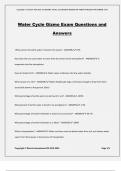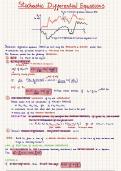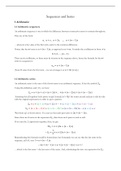Reading Notes Governance Theories
Inhoud
Chamberlin (1965) The method of multiple working hypotheses............................................................3
Institutionalism............................................................................................................................................5
Hall & Taylor (1996) Political science and the three new institutionalisms............................................5
Advocacy Coalition Framework...................................................................................................................8
Sabatier Chapter 4...................................................................................................................................8
Social Construction and Policy Design.......................................................................................................12
Schneider et al.......................................................................................................................................12
Punctuated Equilibrium Framework..........................................................................................................16
Sabatier Chapter 2.................................................................................................................................16
Transition theory.......................................................................................................................................20
Geels (2002) Technological transitions as evolutionary reconfiguration processes...............................20
Wieczorek & Hekkert (2012) Systemic instruments for systemic innovation problems........................22
Markard et al. (2012) Sustainability transitions: an emerging field of research and its prospects........24
Multiple Streams Framework....................................................................................................................26
Sabatier Chapter 1.................................................................................................................................26
Network Theory.........................................................................................................................................29
Bodin, Crona & Ernstson (2006) Social networks in natural resource management: what is there to
learn from a structural perspective?......................................................................................................29
Janssen et al. (2006) Toward a network perspective of the study of resilience in social-ecological
systems..................................................................................................................................................30
Bodin & Crona (2009) The role of social networks in natural resource governance: what relational
patterns make a difference?..................................................................................................................32
Political Ecology and Social Justice............................................................................................................36
Paulson et al. (2003) Locating the political in political ecology: an introduction...................................36
Ikeme (2003) Equity, environmental justice and sustainability: incomplete approaches in climate
change politics.......................................................................................................................................37
McDermott et al. (2012) Examining equity: A multidimensional framework for assessing equity in
payments for ecosystem services..........................................................................................................40
Social Ecological Systems Theory...............................................................................................................43
Gallardo et al. (?) We adapt … but is it good or bad? Locating the political ecology and social-ecological
systems debate in reindeer herding in the Swedish Sub-Arctic.............................................................43
Folke et al. (2005). Adaptive governance of social-ecological systems..................................................44
1
,Holling (1987). Simplifying the complex: The paradigms of ecological function and structure.............49
Ostrom (2007) A diagnostic approach for going beyond panaceas.......................................................50
2
,Chamberlin (1965) The method of multiple working hypotheses
Two kinds of study
imitation of processes of earlier thinkers
creative study to acquire new knowledge
Methods
1. method of the ruling theory
2. the method of the working hypothesis
3. the method of multiple working hypotheses
Premature theories
danger of making hypotheses based on previous knowledge without investigating thoroughly
lack of thoroughness, impartiality, completeness, all-sidedness, investigation
danger of path dependency in theory, 'love makes the scientist blind for the flaws in his/her own
theory'
a premature explanation passes into a tentative theory, then into an adopted theory and then
into a ruling theory
Attempts at reform
repressive: theorizing should be constrained and only focus on simple determination of facts
o weakness: narrowness and restrictiveness
method of the working hypothesis: used as a means of determining facts
o the facts are sought for the purpose of ultimate induction and demonstration
o hypothesis is a means for the development of facts, their relations, arrangement and
preservation of material for the final induction
o Weakness: danger of path dependency of the hypothesis
method of multiple working hypotheses: bring into view every rational explanation of a new
phenomenon and to develop every tenable hypothesis respecting their cause and history
o Danger that springs from affections is counteracted
o Accounts for complex problems
o Promotes thoroughness
o Fertility in processes --> if the subject is looked at from all sides, the outcomes of means
and methods is full and rich
o Assumes that the acts of people are diverse in their nature
o Less confidence in the completeness of knowledge due to being able to detect
imperfections in knowledge --> less disposition to reach conclusions based on imperfect
grounds --> less misunderstandings, misjudgments, and misrepresentations
o Weakness: complexity makes it harder to work quickly, hard to put multiple lines of
thinking into language --> difficult language
General lack of reflection on methods in academia
Flexibility, selection and adaptation to different methods by teachers and students is needed
3
, If our vision is narrowed by a preconceived theory as to what will happen, we are almost certain
to misinterpret the facts and misjudge the issue
Limitations of the method
Sometimes a consistent poorer line of action yields better results than a vacillation between
better policies
Method presumes a mind sensitive to all evidence, but this may hamper effective and timely
decision making in practical affairs
4
Inhoud
Chamberlin (1965) The method of multiple working hypotheses............................................................3
Institutionalism............................................................................................................................................5
Hall & Taylor (1996) Political science and the three new institutionalisms............................................5
Advocacy Coalition Framework...................................................................................................................8
Sabatier Chapter 4...................................................................................................................................8
Social Construction and Policy Design.......................................................................................................12
Schneider et al.......................................................................................................................................12
Punctuated Equilibrium Framework..........................................................................................................16
Sabatier Chapter 2.................................................................................................................................16
Transition theory.......................................................................................................................................20
Geels (2002) Technological transitions as evolutionary reconfiguration processes...............................20
Wieczorek & Hekkert (2012) Systemic instruments for systemic innovation problems........................22
Markard et al. (2012) Sustainability transitions: an emerging field of research and its prospects........24
Multiple Streams Framework....................................................................................................................26
Sabatier Chapter 1.................................................................................................................................26
Network Theory.........................................................................................................................................29
Bodin, Crona & Ernstson (2006) Social networks in natural resource management: what is there to
learn from a structural perspective?......................................................................................................29
Janssen et al. (2006) Toward a network perspective of the study of resilience in social-ecological
systems..................................................................................................................................................30
Bodin & Crona (2009) The role of social networks in natural resource governance: what relational
patterns make a difference?..................................................................................................................32
Political Ecology and Social Justice............................................................................................................36
Paulson et al. (2003) Locating the political in political ecology: an introduction...................................36
Ikeme (2003) Equity, environmental justice and sustainability: incomplete approaches in climate
change politics.......................................................................................................................................37
McDermott et al. (2012) Examining equity: A multidimensional framework for assessing equity in
payments for ecosystem services..........................................................................................................40
Social Ecological Systems Theory...............................................................................................................43
Gallardo et al. (?) We adapt … but is it good or bad? Locating the political ecology and social-ecological
systems debate in reindeer herding in the Swedish Sub-Arctic.............................................................43
Folke et al. (2005). Adaptive governance of social-ecological systems..................................................44
1
,Holling (1987). Simplifying the complex: The paradigms of ecological function and structure.............49
Ostrom (2007) A diagnostic approach for going beyond panaceas.......................................................50
2
,Chamberlin (1965) The method of multiple working hypotheses
Two kinds of study
imitation of processes of earlier thinkers
creative study to acquire new knowledge
Methods
1. method of the ruling theory
2. the method of the working hypothesis
3. the method of multiple working hypotheses
Premature theories
danger of making hypotheses based on previous knowledge without investigating thoroughly
lack of thoroughness, impartiality, completeness, all-sidedness, investigation
danger of path dependency in theory, 'love makes the scientist blind for the flaws in his/her own
theory'
a premature explanation passes into a tentative theory, then into an adopted theory and then
into a ruling theory
Attempts at reform
repressive: theorizing should be constrained and only focus on simple determination of facts
o weakness: narrowness and restrictiveness
method of the working hypothesis: used as a means of determining facts
o the facts are sought for the purpose of ultimate induction and demonstration
o hypothesis is a means for the development of facts, their relations, arrangement and
preservation of material for the final induction
o Weakness: danger of path dependency of the hypothesis
method of multiple working hypotheses: bring into view every rational explanation of a new
phenomenon and to develop every tenable hypothesis respecting their cause and history
o Danger that springs from affections is counteracted
o Accounts for complex problems
o Promotes thoroughness
o Fertility in processes --> if the subject is looked at from all sides, the outcomes of means
and methods is full and rich
o Assumes that the acts of people are diverse in their nature
o Less confidence in the completeness of knowledge due to being able to detect
imperfections in knowledge --> less disposition to reach conclusions based on imperfect
grounds --> less misunderstandings, misjudgments, and misrepresentations
o Weakness: complexity makes it harder to work quickly, hard to put multiple lines of
thinking into language --> difficult language
General lack of reflection on methods in academia
Flexibility, selection and adaptation to different methods by teachers and students is needed
3
, If our vision is narrowed by a preconceived theory as to what will happen, we are almost certain
to misinterpret the facts and misjudge the issue
Limitations of the method
Sometimes a consistent poorer line of action yields better results than a vacillation between
better policies
Method presumes a mind sensitive to all evidence, but this may hamper effective and timely
decision making in practical affairs
4












